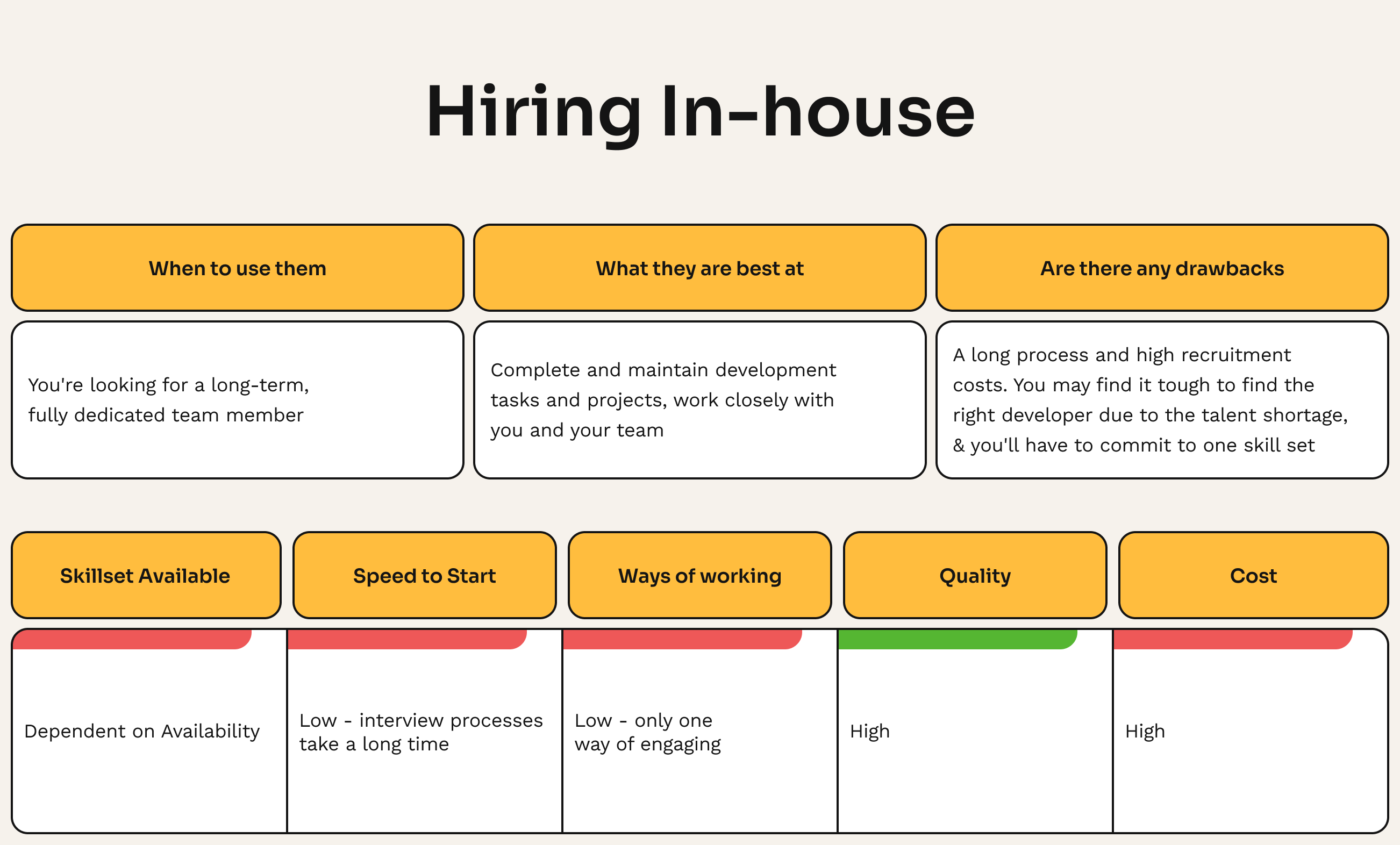For the past decade or more, having a high performing tech team has been the ambitious aim of many companies and tech leaders. However, the seemingly never-ending tech talent crunch, increasing costs of hiring, and the difficulty of retaining teams can mean the dream of having all of your tech resources in-house is an increasingly expensive and less viable option.
Let's delve into the advantages (and occasional drawbacks) of having an in-house team for software development, from choosing the right skills and cultural fit to the long-and-short-term cost implications, and beyond.
Remember, if you'd like a broader view of alternatives, be sure to check out our comprehensive guide and infographic.

Cultural Harmony vs Talent Scarcity: The In-House Skillset Dilemma
Boosting Business Culture: The Advantage of In-House Expertise
An in-house team exists as part of your company's culture and ethos.
Hiring in-house allows you to find a long-term, dedicated team member who aligns with your work culture.
You're not only investing in their skills but also their assimilation into your business culture, so this approach offers a significant advantage in terms of team cohesion and alignment.
It's also often the best possible answer for long-term projects and strategic applications. You'll have ongoing access to a range of talent that intimately understands the context of your business, and the ways of working which suit you and the wider team best. In addition, if you have a digital product or project which requires ongoing maintenance or updates, you’ll also be able to access a wealth of internal knowledge to ensure they proceed with minimum service disruptions.
Navigating Talent Pools: The Drawbacks of In-House Skillset Selection
The process of hiring in-house, however, is often constrained by the available talent pool and the specific skill sets you're looking for.
The tech world faces a talent shortage, which makes finding qualified developers challenging. Also, once hired, you may find yourself locked into a particular set of skills, which could limit your flexibility when project needs change.
To keep up, you'll need to invest in the ongoing…, well, 'development' of your developers, alongside your internal tech stack.
Collaboration vs Initiation Speed: The Two Faces of In-House Teams
Bridging Gaps: The Power of Collaboration in In-House Teams
Once onboarded, an in-house developer can participate in all aspects of day-to-day activities, leading to seamless collaboration and communication. The developer becomes an integral part of the team, contributing to discussions and decision-making processes. Managed correctly, you'll have an in-house team that is continually improving and broadening its skillset.
In addition, with all of your developers working so closely together and maintaining familiarity with each other's work, you'll also protect yourself against a single point of failure, downtime or delays, as you'll have multiple backups in place.
Racing Against Time: The Drawbacks of In-House Hiring Speed
One of the major downsides to hiring in-house is the time-consuming nature of the process. From finding the right calibre of candidate to conducting interviews and onboarding the new hire, the timeline can be long.
If speed is a critical factor for your project, this might pose a real challenge, especially given the aforementioned skills shortage. In any industry, finding the right fit can be difficult, and this is often doubly true in tech roles.
Understanding the In-House Work Approach
Synced for Success: The Unified Approach of In-House Teams
In-house teams typically adhere to a uniform way of working, which is in sync with the company's established protocols and processes. This harmony in the workflow leads to efficient coordination, fostering a conducive environment for a smooth execution process. It also means an overall less chaotic and more predictable working environment.
An in-house team also brings the benefit of seamless communication as there is no time zone difference or language barrier to deal with. This can lead to faster decision making, less misunderstanding, and ultimately, better project outcomes.
Also, when your team works in-house, all the intellectual property created during the project stays within the company. This can be a significant advantage in projects where proprietary technology or sensitive data is involved.
The One-Size-Fits-All Dilemma: The Effects of Limited Capacity on In-House Teams
However, this uniformity (as comforting as it may be) also presents a set of challenges, particularly when a team is operating at, or near, full capacity for prolonged periods of time.
Given the ongoing tech talent shortage, it’s inevitable that in-house teams may be stretched.
On a personal level, grappling with mounting workloads and the accompanying stress can severely diminish productivity and overall job satisfaction, ultimately leading to lower retention rates. Without significant investment, this can be a difficult challenge to overcome.
In the short-term, this also means slower project delivery, causing delays that hinder an organisation's agility in a fast-paced market.
Without a way to scale capacity to meet mounting deadlines, you could also end up sacrificing quality – of code, testing, documentation, or most importantly, communication. This isn’t the individual fault of team members or managers, simply a difficult reality for growing businesses.
Finally, with the lion's share of their time devoted to immediate tasks, there's scant opportunity for innovation or skill development, which can mean you lag behind in adopting emerging technologies or methodologies.
Capacity Expansion or Skill Stagnation? Assessing In-House Team Flexibility
Scaling on Demand: Understanding In-House Team Capacity
The flexibility of an in-house team can fluctuate significantly based on the number of staff hired and the workload at any given time. As the team grows, so does its capacity to take on more projects or tackle larger initiatives. This allows for a dynamic adjustment to business needs and the ability to scale up or down depending on project requirements and timelines.
Tied to a Track: The Downside of Rigid Skill Set Commitment
However, there's a significant disadvantage to this approach, particularly when it comes to technological expertise. Once a developer is hired with a specific skill set, the company is essentially locked into that expertise.
If the project scope or technological needs shift, changing this requires extensive retraining or adding more members to the team with the requisite skills, which can be a lengthy and resource-intensive process. This inflexibility could potentially limit the company's agility in the face of changing project requirements or market conditions.
Long-term Gains vs High Costs: The In-House Team Cost
Investing in Growth: The Long-Term Value of In-House Partnerships
In-house developers become long-term partners and contributors to the company's growth. They not only lend their expertise to projects but also contribute to the knowledge base of the organisation. Their consistent support and input, borne out of a deep understanding of the company's ethos and objectives, offer high value in the long run.
Another key advantage that's often overlooked is the accumulation of institutional knowledge. In-house team members, being immersed in the company's processes and culture, become repositories of invaluable knowledge about your company's systems, product, and history. They can use this knowledge to solve problems more efficiently and create more innovative solutions.
There's also typically a higher level of trust with in-house employees, as they are part of the same organisational culture and bound by the same rules and regulations.
The Hidden Costs of In-House Hiring
The cost of hiring in-house, both initial and ongoing, can be high. The process involves recruitment costs, payroll, employee benefits, and other overheads such as office space, utilities, and software licences. These costs can add up quickly, making it imperative to consider your long-term budgetary constraints before deciding to expand your in-house team. Make sure your investment will give you a sustainable ROI.
In-house employees typically have less flexibility compared to freelancers or contract workers. This can result in higher costs if your business has seasonal fluctuations or if a project suddenly scales down.
Additionally, hiring in-house means taking on additional legal responsibilities and liabilities as an employer. This includes compliance with labour laws, providing insurance, dealing with employment disputes, and more. Such responsibilities not only take time and resources to manage, but they also carry the risk of legal issues if not handled correctly.
Conclusion
An in-house team provides invaluable cultural fit and long-term partnership, and a sense of continuity that contract-based or temporary workers often cannot match. However, the costs, time commitment, and limitations in skill set flexibility are significant factors that must be considered. When you decide to hire or expand in-house, you're investing in long-term growth, but you also need to be prepared for the high initial and ongoing costs and the potential difficulty in finding the right talent.
Building an in-house team isn't just about filling seats, it's about building a unit that works harmoniously together, shares a common culture, and is dedicated to the company's vision. While this offers numerous advantages such as a unified work approach and high collaboration, the process to reach this stage is often long and can be expensive.
Hiring the right tech talent is still a challenge for many businesses. While there’s no denying the value of an in-house team, it can prove an unwieldy solution if you need to pivot your priorities or take on multiple projects - and the associated delays and costs of hiring can mean you face an opportunity cost, where you cannot capitalise fully on new developments in time.
Is focusing solely on in-house still a viable strategy?
Hiring the right tech talent is still a challenge for many businesses.
While there’s no denying the value of an in-house team, it can prove an unwieldy solution if you need to pivot your priorities or take on multiple projects - and the associated delays and costs of hiring can mean you face an opportunity cost, where you cannot capitalise fully on new developments in time.
Instead of concentrating entirely on finding the perfect mix of in-house talent, it may be more prudent to fill core positions and look at augmenting capacity through different means.
Understanding these pros and cons will help you make a well-informed decision tailored to your organisation's unique needs and circumstances.
Want to know more? Make sure you check out or comprehensive overview of resourcing models. If you have a project you'd like help with, we'd love to hear from you.
